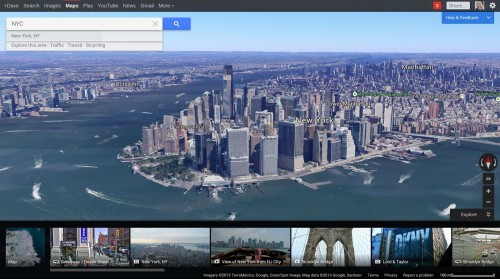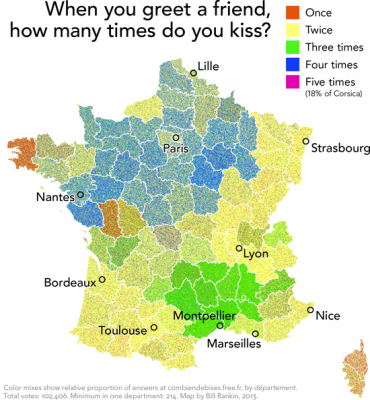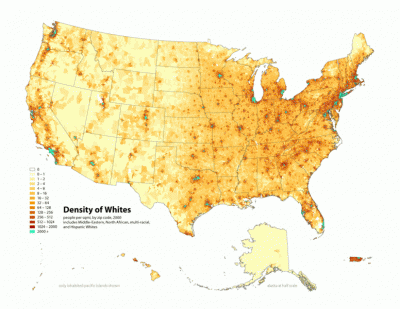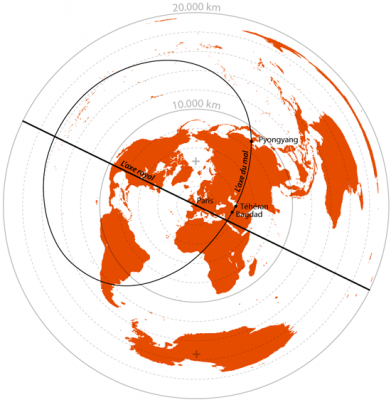
Maps are always political. Most maps show us something that we already believe, so its difficult to see what is being reinforced and what is systematically ignored. Even the most mundane AAA maps of highways and state borders are doing political work by recognizing the sovereignty of individual states and the obduracy of highways and roads. The near-infinite number of things, qualities, measurements, and people that have spatial characteristics (seriously, just think of all of it: temperatures, ancestral lands, endemic species, isobars, places to buy smoothies, locations of hidden treasure, and so on, and so on…_) mean that map makers must always select what is relevant and what is not. This selection process—a human endeavor—is inherently social and deeply political. Google, a company that has taken upon itself to reject that selection process and “organize all the world’s information,” wants to provide a single map and, instead of deciding what is relevant in any given map, will personalize it based on information it has about you and your friends. Evgeny Morozov, writing in Slate,[1] is rightfully concerned that Google doesn’t quite know what they’re dealing with when they say they want to organize public spaces in their databases right next to email and photos of cats. He is concerned that–unlike books or weather forecasts—Google doesn’t “acknowledge the vital role that disorder, chaos, and novelty play in shaping the urban experience.” I completely agree that unpredictability is necessary for good urban space, but the biggest threat Google poses to public space isn’t that its maps are “profoundly utilitarian, even selfish in character.” Rather, Google hasn’t done enough to personalize maps in such a way that they become part of everyday social (and Social) life.

Maps are so good at their job of transforming abstract ideas into visible entities that we often conflate the two. If I were to ask you “what does Portugal look like?” you you’d probably show me a map. A map is a representation or sign of the actual object but we generally accept a map as the “correct” answer because a nation-state isn’t something tangible that we can pick up and observe. This hyperreal state, where the signified political entity is indistinguishable from the signifying map, means that changes in maps can have a very tangible impact on our built environment. Maps aren’t just representations of the world, they are also tools for shaping the environment.
One of the many ways the mutual shaping of maps and landscapes occurs is through the enabling and affording of individual action. By spatially ordering information, maps make it easier to see patterns and make certain kinds of decisions. The first thing Nextdoor, an iPhone app advertising itself as a “private social network for your neighborhood,” asks you to do when setting up a new neighborhood is to draw a border on a Google map. Drawing borders might be one of the more basic things you can do with a map, but its also one of the most important. The border in Nextdoor is a prerequisite for any and all action within your neighborhood. The app doesn’t work–technically nor conceptually– without those borders. Similarly, a map that barely makes mention of major highways or borders and focuses mainly on biking paths, enables a myriad of bike-related activity while relegating highways to nothing more than obstacles. While the mapmaker might have a particular user in mind, maps can be appropriated for many different purposes. A map of North American bike trails can be useful to a radical luddite or a bourgeois cyclist. Both may have gotten it from the Adventure Cycling Association, and use it for totally different ends. The former might use it to find some federal land to squat on, while the latter will use it to find the trail that does the most for their gluteus.
This concept of mutual shaping, paired with ambiguous user intentionality, gets at the heart of the danger of personalized maps and my disagreement with Morozov: When we go out and act with our personalized maps in hand, we shape the world in our image but sometimes not in ways that the map maker (or programmer) intended. Weird things happen when an algorithm can tell a coffee snob that a new purveyor of Blue Bottle Coffee opened up in a neighborhood they usually don’t walk through. It could mean gentrification happens faster, or that “districts” no longer serve the function they once did. It could also mean something totally different that only the best science fiction writers can imagine. Personalized Google maps could turn us into the predictable and computer-readable people that Morozov says it will, but it might makes us more willing to investigate new and different parts of our towns and cities.
Morozov warns, “If Google has its way, our public space might soon look like the Californian suburbia that the company calls home: nice but isolated, sunny but relying on decrepit infrastructure, orderly but segregated by income.”

Given that just about half of Americans live in suburbs, it makes sense that Google has put a lot of thought into mapping them. Does that automatically mean that Google wants to terraform the Earth to look like Santa Clara County? Not necessarily. Google Maps, in its current incarnation, works best in the suburbs and huge metropolises, but that probably has more to do with following where the users are, than any kind of preference for a particular built environment. A major shift in built environments would not be in Google’s interest, but that is different from saying that the suburbs are what Google would make if it could choose from any kind of built environment.
This is not to say however, that Google doesn’t benefit from particular sociotechnical arrangements. Systems interact with the least amount of friction when they are isometric. Social construction of technology theorists like Thomas Hughes noted that big technical systems beget human organizations and bureaucracies with a similar size and shape. Cities built for cars and computers built for networks have a lot in common: they have huge arteries and backbones that end in tiny capillaries, cul-de-sacs, and routers. Its no coincidence that the highway was an early metaphor for describing the Internet: it compresses space, relies on a simple hierarchy to order completely unconnected units (cars and packets), and connects people quickly with a ruthless kind of self-justifying technique. Whatever is in Google’s interest is probably big and complex, but not necessarily California suburb. It could also be New York City or Shanghai.
Morozov isn’t wrong when he says, “enriching the database—rather than our urban experience—is the company’s primary objective.” But the database and our urban experience are deeply enmeshed and, sometimes, interchangeable. My reviews and Foursquare check-ins are intertwined with past memories; imaginaries of new or yet-to-exist places are prefigured with stories from friends and photos I found on a travel blog. In short, whether or not Google is interested solely in its database or the urban experience is beside the point. The city is subject to observer effects: it changes in unpredictable ways just by watching it. Rather than thinking about what Google wants, we should be concerned about what their actions ultimately produce.
The urban experience, to the extent such a dubious unity can even be said to produce self-similar experiences at all[2], is paradoxically highly orchestrated and totally unpredictable. Thousands of things have to happen the same way everyday—buses running, water flowing, people exchanging money—but each day is just one of an infinite number of combinations. Google’s job, in many ways, will never be done because the city is one long emergent phenomenon, constantly being remade and reordered. Any one of Google’s engineers that have been working on the self-driving car can attest to the infinite complexity of a single pre-planned car route.
Enriching the urban experience does not necessarily make it more difficult to enrich the database. Observer effects are famously difficult to predict or even notice once they’re happening. Highways were thought to be the answer to cities’ traffic congestion. By making huge roads that never have to stop, planners and engineers thought they were ushering in a new era of easy motoring. When congestion got worse, their immediate decision was to add more highways. Now we know that this line of thinking makes about as much sense as buying bigger pants to lose weight—it just doesn’t make sense. Efforts to reduce car traffic through better information will probably yield similar results. Making it easier to drive will never reduce the amount of drivers. Seeking to reduce friction at such a large scale will always lead to unintended consequences.
Google only makes money on the promise that they are well positioned to sway people as they are making decisions about where to go and what to buy. According to Morozov:
The best way to do that is to actually turn us into highly predictable creatures by artificially limiting our choices. Another way is to nudge us to go to places frequented by other people like us—like our Google Plus friends. In short, Google prefers a world where we consistently go to three restaurants to a world where our choices are impossible to predict.
I’m having a hard time imagining the ideal three-restaurant scenario. When did anyone choose their top three restaurants and where do these new people come from? When do they choose their top three? If everyone already has their three places, who is being convinced by their Google Plus to eat at new places? Why would Google want consistency when they make money by facilitating businesses’ ability to change your mind through advertising?
To summarize, Google’s personalized maps may intend to do what Morozov says: turn public spaces into frictionless and lifeless pathways to Yelp-reviewed destinations, but historically such efforts have failed. Observer effects combined with the sheer unpredictability and complexity of large sociotechnical systems means that neither databases nor urban experiences follow the other. Rather, they are in a constantly emerging process of mutual shaping and never fully formed or complete. Given this reality, we should care less about Google’s stated or perceived intentions, and focus more on what their actions end up producing.

I want to conclude by offering up the possibility that personalized maps is nothing new, but the opportunity to see and share these maps could potentially reinvigorate our public spaces. In the late 50s, MIT urban planner and architect Kevin Lynch asked residences of Boston, Los Angeles, and Jersey City to draw a map of their city. He found that while individual maps were distorted, the distortions almost disappeared in the aggregate. One person might forget the existence of an entire boulevard or transpose the order of churches going North to South, but overall the maps were fairly accurate. Lynch, while acknowledging that his sample sizes weren’t very representative or large (30 in Boston, 15 in Los Angeles and Jersey City, all of middle and upper income) couldn’t help but comment on how strong and predictable the trends were. People with cars would see highways as smaller than they actually were (the speed of the car tends to reduce perceived distance), while pedestrians tended to exaggerate the size of the highway (because it was a nuisance and an obstacle, rather than a useful path).
Lynch concluded that we all have an “image of the city” in our minds that exaggerate salient features and actively delete places that do not serve a purpose in our daily lives. We’ve always had personalized maps, but up until recently, lacked the tools to effectively share them with each other on a consistent basis or in useful ways. Personalized Google maps, so long as they provide an opportunity for sharing, could provide some of the richest, most evocative maps to date. The over-lapping of millions of personal maps will illuminate hot public spaces and identify emerging new ones. The key here is whether or not Google lets us compare our maps. It seems like a killer social media function so there’s no reason not to. Morozov says, “no one formally reviews public space or mentions it in their emails” but I beg to differ. You can check into all sorts of public spaces on Foursquare (even airport terminals) and I wrote a lot of emails about public space when I was actively involved in Occupy. Google has lots of information on public space, and given they’re on gigantic private corporation, that seems to be precisely the problem.
Morozov quotes a really telling passage from Google’s press announcement. It reads,
In the past … a map was just a map, and you got the same one for New York City, whether you were searching for the Empire State Building or the coffee shop down the street. What if, instead, you had a map that’s unique to you, always adapting to the task you want to perform right this minute?
That’s just wrong. Tourists get a map with all the destinations highlighted. If you’re visiting from out of town, a friend might draw a map on a bar napkin. AAA’s triptik planner has been around for ages. Informal, personalized maps have always been around (they used to be the only maps when you think about it) the difference is in the wealth of information, the accuracy, how quickly they can be produced, and the centralization of ownership. The press release is a classic misdirection, Google’s innovation isn’t the personalization, its how lots of different personalized maps are connected to one-another and owned by a single private entity. The real danger from maps come not only from the potential corporate disinterest in letting people share their image of the city, but also from Google’s ability to actively delete objects from our collective memory. If Google destroys public space, it won’t be from a new invention, it’ll be from taking away an invention we’ve come to rely upon.
David A. Banks is on Twitter: @da_banks
[1] This reply is somewhat belated, since I am only just emerging from a hole of exams and subsequent fieldwork.
[2] I’ll admit I do not really know what Morozov means when he says “the urban experience” let along what “enriching” it looks like. I take “the urban experience” to mean anything having to do with the sensorial and affective components of everyday life in a city. Enriching such an experience may mean simply increasing these components by some degree or something more than the sum of their parts.

Comments 9
Edgar — June 5, 2013
I'm interested on your thoughts, if any, on OpenStreetMap.org. Being an open database with a liberal system of tagging features, anyone can copy or alter the map to their content. It takes a bit more technical knowledge than an individualized Google Map, but the results can be much more powerful.
Here are a few examples of specialized maps that can be made with OSM data:
http://maps.stamen.com
http://www.opencyclemap.org/
Whether changing the display of a rendered map through code, editing the OSM database directly, or overlaying your own data layer, individuals have never had as much power to create their own interpretation of the world.
Google Maps Can’t Kill Public Space (A Belated Reply to Evgeny Morozov) » Cyborgology | EggBlog — June 5, 2013
[...] via Google Maps Can’t Kill Public Space (A Belated Reply to Evgeny Morozov) » Cyborgology. [...]
Google Maps Can’t Kill Public Space (A Be... — June 6, 2013
[...] Maps are always political. Most maps show us something that we already believe, so its difficult to see what is being reinforced and what is systematically ignored. Even the most mundane AAA maps of highways and state borders are doing political work by recognizing the sovereignty of individual states and the obduracy of highways and roads. The near-infinite number of things, qualities, measurements, and people that have spatial characteristics (seriously, just think of all of it: temperatures, ancestral lands, endemic species, isobars, places to buy smoothies, locations of hidden treasure, and so on, and so on…_) mean that map makers must always select what is relevant and what is not. This selection process—a human endeavor—is inherently social and deeply political. Google, a company that has taken upon itself to reject that selection process and “organize all the world’s information,” wants to provide a single map and, instead of deciding what is relevant in any given map, will personalize it based on information it has about you and your friends. Evgeny Morozov, writing in Slate,[1] is rightfully concerned that Google doesn’t quite know what they’re dealing with when they say they want to organize public spaces in their databases right next to email and photos of cats. He is concerned that–unlike books or weather forecasts—Google doesn’t “acknowledge the vital role that disorder, chaos, and novelty play in shaping the urban experience.” I completely agree that unpredictability is necessary for good urban space, but the biggest threat Google poses to public space isn’t that its maps are “profoundly utilitarian, even selfish in character.” Rather, Google hasn’t done enough to personalize maps in such a way that they become part of everyday social (and Social) life. [...]
Atomic Geography — June 6, 2013
Fine thought provoking post.
I aagree with you that Google's interests are not served by a standardization of the built environment. After all who needs a map to negotiate a McD's.
As you write: "Informal, personalized maps have always been around (they used to be the only maps when you think about it) the difference is in the wealth of information, the accuracy, how quickly they can be produced, and the centralization of ownership." I think that is to say the difference is the digitization. I also think that this illustrates why the opposite pole to the digital is not the physical, but the analog. Frequently discussions of the digital focus on communication devices, leading us into a discussion of interioroity vs physical.
But I think the vast amount of digitized info is some form of mapping enabling some other mechanism or process to proceed at a greater order of magnitude than it would if using analog information coding. Personal communication is just the most visible pixel.
Expanding these thoughts slightly is http://atomicgeography.com/2013/04/08/digitism-part-3-analog-and-digital/
I'm a little unclear though about the conclusion to your post.
"The real danger from maps come not only from the potential corporate disinterest in letting people share their image of the city, but also from Google’s ability to actively delete objects from our collective memory. If Google destroys public space, it won’t be from a new invention, it’ll be from taking away an invention we’ve come to rely upon."
What would be the mecahanism for this?
In Their Words (with special NSA section) » Cyborgology — June 9, 2013
[...] “Google’s job, in many ways, will never be done because the city is one long emergent phenomenon, c...” [...]
The Maps In Our Minds | The Penn Ave Post — June 10, 2013
[...] at 8:15 on June 10, 2013 by Andrew Sullivan David Banks posts a belated reply to Evgeny Morozov, who recently cautioned against the dangers of [...]
Google Maps Can’t Kill Public Space (A Be... — June 10, 2013
[...] [...]
Friday Roundup: June 7, 2013 » The Editors' Desk — April 1, 2014
[…] the intersection of game design and digital dualism to cell phones and surveillance, Google Maps and public space to music spammers and authenticity and […]